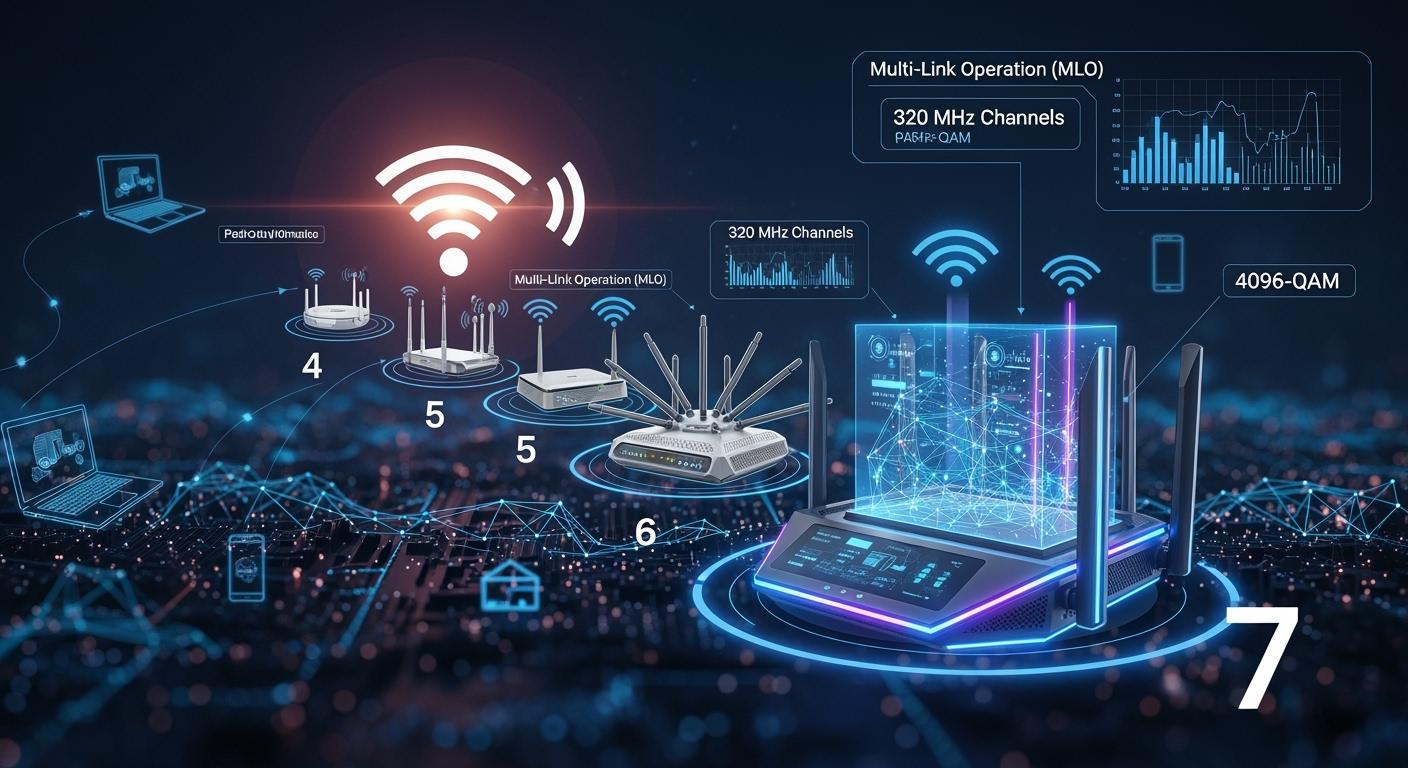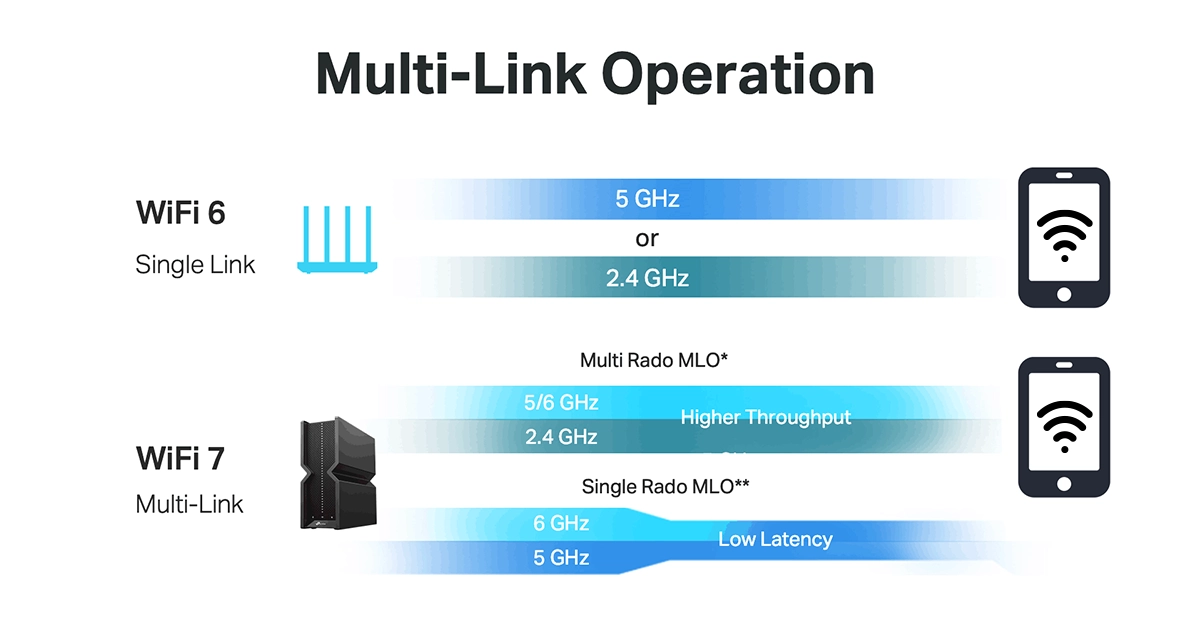
WiFi 7 is special because it gives you faster speeds. It also gives you smarter connections and better performance than older wi-fi standards. You will see smoother streaming and gaming at home. Wi-fi 7 uses multi-link operation for stronger stability. It also uses wider channels for more bandwidth. These upgrades help you have less lag and fewer breaks.
Faster speeds help you download big files fast.
Multi-link operation makes your connection stay strong.
Wider channels send more data to your devices.
📝 Key Takeaways
WiFi 7 can reach speeds up to 46Gbps. This lets you download things quickly. You can stream 4K and 8K videos without problems.
Multi-Link Operation uses more than one band. This keeps your connection strong. It helps lower lag. It makes your internet work better in busy places.
Wider channels can be as big as 320MHz. This lets more data move at the same time. Your network works well even with lots of devices.
WiFi 7 has lower latency. This means you get faster responses. Gaming and video calls are smoother. Online activities are more fun.
Getting WiFi 7 helps homes and businesses with many devices. It gives you fast and steady internet. You can count on your connection.
📝 What Exactly is WiFi 7?
WiFi 7 is the upcoming Wi-Fi standard, building upon the solid foundation laid by WiFi 6 and WiFi 6E. Its official technical name is 802.11be - Extremely High Throughput (EHT). As the name suggests, the primary goal is to push data speeds, efficiency, and reliability to unprecedented levels.
Designed for a world with an ever-growing number of connected devices—from smartphones and laptops to AR/VR headsets and smart home ecosystems—WiFi 7 addresses the limitations of current networks. It’s engineered to handle massive data loads with minimal latency, making it the backbone for future technologies like the metaverse and 8K streaming.
📝 Key Features & Technological Breakthroughs
WiFi 7 introduces several groundbreaking technologies that work in concert to deliver a superior performance. Understanding these key WiFi 7 specifications is crucial to appreciating its potential.
320 MHz Channel Width: While WiFi 6E introduced the 6GHz band, WiFi 7 doubles the maximum channel width within it. Think of channels as highways; a 320MHz highway is twice as wide as the 160MHz one in WiFi 6, allowing for a massive increase in data traffic and raw speed.
4K QAM (Quadrature Amplitude Modulation): This is a more efficient way of packing data into each transmission. Compared to the 1024 QAM in WiFi 6, 4K QAM encodes 20% more data in the same signal, resulting in faster speeds for devices close to the router.
Multi-Link Operation (MLO): This is arguably the most revolutionary feature. Currently, your device connects to a single band (2.4 GHz, 5 GHz, or 6 GHz) at a time. MLO allows a device to simultaneously transmit and receive data across multiple frequency bands. This not only aggregates speed but also drastically reduces latency and provides seamless roaming, as the connection can instantly switch bands to avoid congestion.

📝 WiFi 7 vs. WiFi 6 & WiFi 5: A Generational Comparison
To truly grasp the advancement, let's see how WiFi 7 stacks up against its predecessors. This comparison is essential for anyone considering a WiFi 7 router upgrade or planning future-proof network infrastructure.
Feature | WiFi 5 (802.11ac) | WiFi 6 (802.11ax) | WiFi 7 (802.11be) |
|---|---|---|---|
Max Theoretical Speed | ~3.5Gbps | ~9.6Gbps | Up to 46Gbps |
Frequency Bands | 5GHz only | 2.4GHz, 5GHz | 2.4GHz, 5GHz, 6GHz |
Max Channel Width | 160MHz | 160MHz | 320MHz |
Modulation | 256 QAM | 1024 QAM | 4K QAM |
Key Technology | MU-MIMO (Downlink) | MU-MIMO (Uplink/Downlink), OFDMA | Multi-Link Operation (MLO), 4K QAM |
Best For | Basic HD streaming & browsing | Modern smart homes & multiple devices | 8K streaming, VR/AR, low-latency gaming |
As the table illustrates, the performance gap is substantial. For users looking for seamless multi-gigabit connectivity, the transition to WiFi 7 will be a transformative experience.
📝 Real-World Benefits: Why You Should Care
You might be wondering how these technical specs translate to your daily life. Here are the tangible benefits:
Blistering Speeds for Data-Heavy Tasks: Download large files, backup to the cloud, and stream 8K video in the blink of an eye.
Rock-Bottom Latency for Gamers and Pros: MLO ensures a stable connection, eliminating lag spikes in competitive gaming and making video conferencing buttery smooth.
Superior Performance in Crowded Networks: Perfect for large families, offices, and public venues where dozens of devices are competing for bandwidth.
Future-Proofing Your Home or Business: Adopting WiFi 7 now means your network will be ready for the next wave of connected devices and applications.
📝 The Unsung Hero: Optical Modules in a WiFi 7 Ecosystem
When we talk about a high-speed home network setup, the focus is often on the wireless router. However, the wireless experience is only as good as the wired backbone that supports it. This is where optical modules become critical.
A WiFi 7 router, capable of multi-gigabit speeds, requires an internet connection that can keep up. If your router can handle 10Gbps but your connection from your Internet Service Provider (ISP) is only 1Gbps, you've created a bottleneck. Optical modules, or optical transceivers, are the components used in networking equipment to convert electrical signals into light, transmitting data over fiber optic cables at incredible speeds and over long distances with minimal loss.
To fully leverage the power of WiFi 7, the entire network chain—from the ISP's core network to the gateway in your home—must be upgraded. High-performance optical modules are essential in the backhaul and fronthaul networks that feed data to your wireless access points. For a robust and future-proof installation, choosing reliable components is key.
For instance, the LINK-PP 25G SFP28 SR Optical Module is an ideal solution for delivering the necessary backhaul capacity to support a WiFi 7 network. Its high reliability and low power consumption make it a perfect fit for both service providers and enterprises looking to build a foundation that can handle the demands of next-generation wireless technology without any bottlenecks.
📝 How to Prepare for the WiFi 7 Revolution
WiFi 7 is finalized in 2024, with compatible devices steadily entering the market. Here’s how you can get ready:
Audit Your Current Gear: Your existing smartphones, laptops, and IoT devices won't support WiFi 7. You'll need new client devices that are certified for the new standard.
Evaluate Your Internet Plan: Consider upgrading to a multi-gigabit internet plan from your ISP to match the potential of your future WiFi 7 router.
Think About Your Network Infrastructure: Ensure your internal network wiring (e.g., Cat 6a or better) and switches can support multi-gigabit speeds. For advanced setups, as discussed, the role of quality components like optical modules cannot be overstated.
Plan Your Purchase: The first wave of best WiFi 7 routers is already available. While it's early, early adopters can experience a significant performance boost today.
📝 Conclusion: The Future is Wireless and Unbelievably Fast
WiFi 7 is not just another step in Wi-Fi evolution; it's a giant leap. With its revolutionary features like Multi-Link Operation and 320MHz channels, it is poised to unlock new possibilities in how we work, play, and connect. While the full ecosystem will take time to mature, the foundation for a wire-like wireless experience is being laid today.
Building this future requires a holistic approach, from the end-user device all the way back to the core network infrastructure. Partnering with technology leaders who provide reliable, high-speed components is crucial for a seamless rollout.
📝 FAQ
What is WiFi 7?
Wifi 7 is the newest wireless standard. You get faster speeds and better performance than older versions. Your devices connect quickly and stay stable. You notice smoother streaming and gaming at home.
What makes Wi-Fi 7 different from previous Wi-Fi standards?
Wi-Fi 7 uses multi-link operation and wider channels. You get higher speeds and lower latency. Your connection stays strong, even with many devices. You experience less lag and more reliable internet.
What devices support Wi-Fi 7?
You find Wi-Fi 7 support in new phones, laptops, and tablets. Some routers and smart home gadgets also use this technology. Check your device’s specifications before upgrading.
What benefits do you get from Wi-Fi 7 at home?
You enjoy faster downloads, smooth video streaming, and quick gaming responses. Your smart home devices work better. Wi-Fi 7 helps every device in your house perform at its best.
What should you consider before upgrading to Wi-Fi 7?
You need compatible devices to use all features. Older devices work with Wi-Fi 7 routers, but you miss top speeds. Look for new electronics with Wi-Fi 7 support for the best results.


